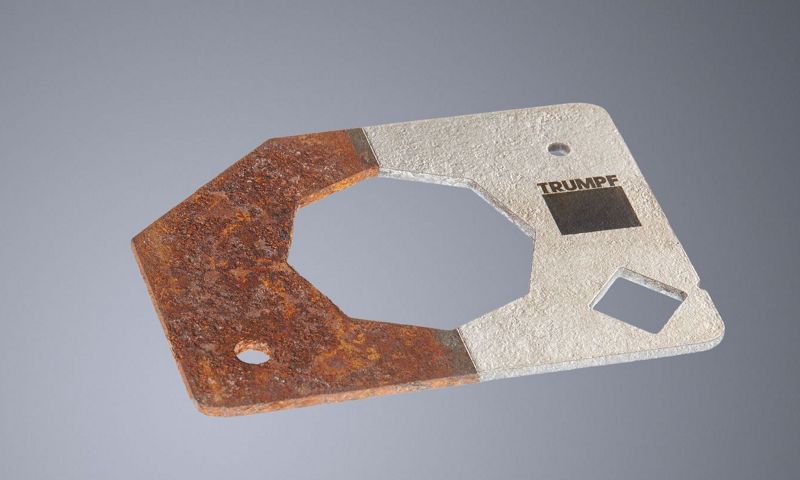Laser technology makes the automotive industry more environmentally friendly

TRUMPF has developed solutions that enable the automotive industry to avoid chemical cleaning processes. Laser technology thus ensures much more environmentally friendly production when cleaning car body parts. "The automotive industry wants to say goodbye to environmentally harmful chemical processes, which are used primarily for cleaning components. With our short pulse lasers, we can make a decisive contribution to sustainable production."
Today, the automotive industry typically cleans components chemically. This requires several baths and chemicals. This is often unnecessary: for example, to prepare bonded joints for the so-called cold body-in-white process, automotive manufacturers often only need to clean and prepare certain areas of the component.
Laser technology cleans and structures body parts in an environmentally friendly way
"Laser technology is benefiting from the trend towards so-called cold body-in-white in the automotive industry, with adhesive joints increasingly being used in body construction. This is where our short-pulse lasers come into their own. Customers save water and chemical cleaning agents compared to conventional processes," says Steffen Rübling, product manager at TRUMPF responsible for short pulse lasers. The short-pulse lasers clean the components only where it is actually necessary. Car manufacturers can dispense with post-processing. Furthermore, laser cleaning always works equally well.
To ensure that the bonded joints hold permanently, automotive manufacturers often must additionally prepare the surfaces - for example, by selectively introducing structures. Here, too, short-pulse lasers are used. "Laser structuring is a clean, fast and non-contact alternative to sandblasting, etching with chemicals or milling. TRUMPF's short-pulse lasers can structure a wide variety of metals," says Rübling. To do this, he says, the user only has to adjust the laser's parameters depending on the metal, such as laser power and process speed. Cleaning the surfaces with wet chemicals or abrasives, on the other hand, requires time-consuming masking of the parts. "This drives up costs and makes cleaning more time-consuming than it needs to be," Rübling says.
Lasers make manufacturing of e-car batteries more sustainable
Short-pulse lasers from TRUMPF also prepare bonded joints in electromobility. Battery manufacturers must glue battery cells for e-cars into the battery pack. To ensure that the adhesive adheres better, the laser cleans and structures the corresponding areas on the metal before bonding. Also used in e-mobility are VCSEL high-power infrared laser systems from TRUMPF Photonic Components. These mini lasers dry battery foils for e-cars. The VCSEL heating systems work with infrared radiation. They thus transfer heat directly and evenly to the entire length of the battery foil and do so almost entirely without energy loss. The process is not only more efficient, but also significantly faster. Compared to standard ovens, the VCSEL heating systems require less energy and also significantly less space in the production line. "Electromobility is one of the most important strategic growth areas for our VCSEL heating systems. We are pleased to contribute to the future of mobility with our solutions by enabling more efficient manufacturing," says Ralph Gudde, responsible for sales at TRUMPF Photonic Components.
Laser technology from TRUMPF helps avoid particulate matter
With high-speed laser metal deposition, TRUMPF has brought a process to industrial maturity that can help reduce brake disc abrasion and thus fine dust emissions. This laser process can also provide corrosion protection, which is particularly important for the brake discs of electric vehicles. These operate with recuperation, i.e. energy recovery, and therefore use the disc brake less frequently. The brake discs therefore accumulate flash rust more quickly, which leads to even more particulate matter when braking and can also necessitate premature replacement. "The combination of high area rate, high layer quality and our approaches to increase efficiency and save powder, make our laser solutions very attractive for an industrial scale application. Just like the automotive industry needs," says Marco Göbel-Leonhäuser, TRUMPF's industry manager for laser metal deposition.
The laser metal deposition principle works through a clever interaction of laser and metal powder. This makes it possible to create pore- and crack-free layers. At the heart of the process is the powder and energy supply. Instead of the metal powder being applied to the component and then melted there by laser light, in high-speed laser metal deposition it enters the laser beam already above the component. The light heats the powder to melting temperature already on its way to the component.
News release from Trumpf, 16/03/2023
Feel free to share
Calendar
14/05 - 16/05: Advanced Manufacturing, Antwerp Expo (B)
15/05 - 16/05: Advanced Engineering, Antwerp Expo (B)
15/05 - 16/05: Food Tech Event, Brabanthallen, 's-Hertogenbosch (Nl)
28/05: Industrie & Maintenance, Namur Expo (B)
05/06 - 06/06: Vision, Robotics & Motion, Brabanthallen, 's-Hertogenbosch
10/06 - 14/06: ACHEMA, Frankfurt am Main (D)
18/09 - 19/09: Kunststoffen, Brabanthallen 's-Hertogenbosch (Nl)
08/10 - 11/10: Motek, Stuttgart (D)
15/09/25 - 19/09/25: Schweissen & Schneiden, Messe Essen (D)
08/10/25 - 15/10/25: K, Düsseldorf (D)
